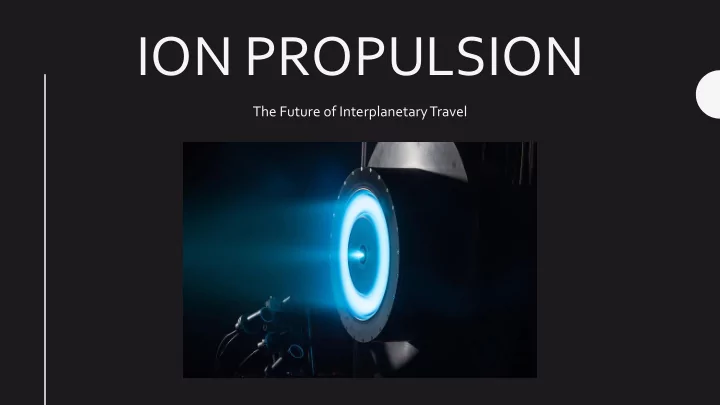

ION PROPULSION The Future of Interplanetary Travel
What is it? • Propulsion system using ionized atoms to provide thrust • Small acceleration for long periods of time • Large changes in speed for long haul missions
How does it work? • Electrons fired at neutral propellant atoms to create charged ions • Charged ions influenced by voltage to move toward rear of engine chamber • Ions fired out of the thruster by charged plates called grids
Ion Thrusters vs. Chemical Rockets • Chemical Rockets provide large amounts of energy in short amounts of time • Ion thrusters provide constant small amounts of energy for extended periods of time • Ion engines do not have the capability to get spacecraft from surface to orbit • Ion engines can be best used for long haul missions in conjunction with chemical rockets
Benefits of Ion Propulsion • Accelerates atoms to 90 km/s • 90% efficiency (vs 35% efficiency traditional propulsion) • Lightweight, requires much less propellant • Reliability, has been tested to run without fail for over 6 years
Uses of Ion Engines • Developed by NASA Glenn since late 1950s • First tested in space 1964 • Deep Space 1 primary propulsion system 1998 • Used on 100s of Earth communication satellites
Future of Ion Engines X3 thruster developed at University of NASA Evolutionary Xenon Thruster Michigan operates at 3x power level of previous (NEXT) has been tested to run for over 6 generation NSTAR thruster years continuously
Works Cited • Cain, Fraser, director. How Do Ion Engines Work? The Most Efficient Propulsion System Out There. YouTube, YouTube, 15 May 2018, www.youtube.com/watch?v=6H0qsqZjLW0. • Dunbar, Brian. “Ion Propulsion.” NASA, NASA, 18 Aug. 2015, www.nasa.gov/centers/glenn/about/fs21grc.html. • Dunbar, Brian. “Ion Propulsion: Farther, Faster, Cheaper.” NASA, NASA, 2004, www.nasa.gov/centers/glenn/technology/Ion_Propul sion1.html. • Esa . “World -First Firing of Air- Breathing Electric Thruster.” European Space Agency, www.esa.int/Our_Activities/Space_Engineering_Technology/World-first_firing_of_air-breathing_electric_thruster. • Pultarova , Tereza. “Ion Thruster Prototype Breaks Records in Tests, Could Send Humans to Mars.” Space.com, Space Created with Sketch. Space, 13 Oct. 2017, www.space.com/38444-mars-thruster-design-breaks-records.html. • “The Ion Propulsion System.” DLR Portal, www.dlr.de/dlr/en/desktopdefault.aspx/tabid -10559/966_read-2028/#/gallery/3906.
Recommend
More recommend